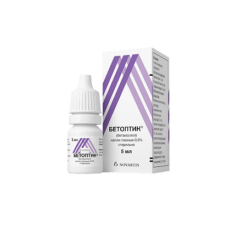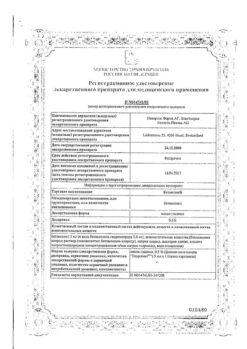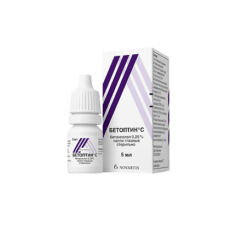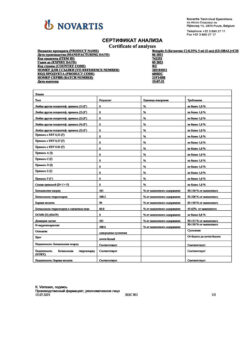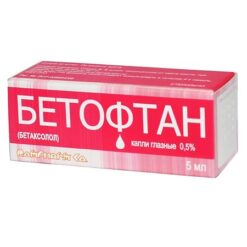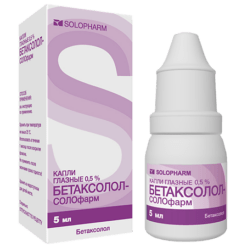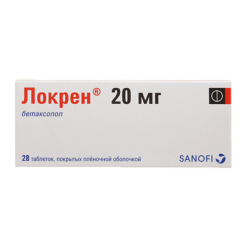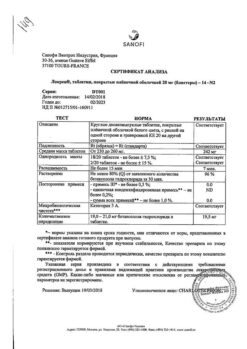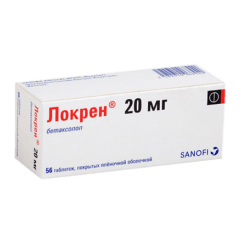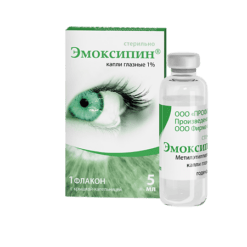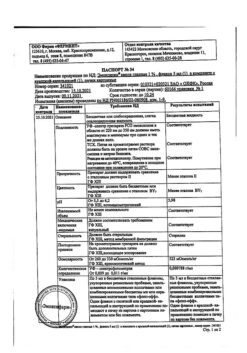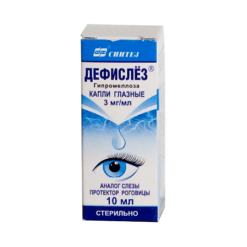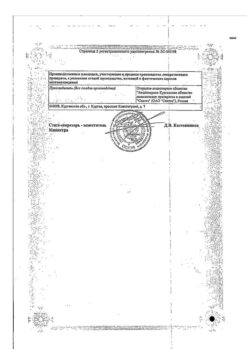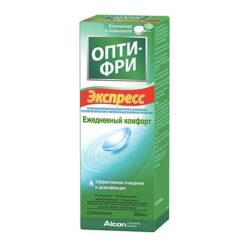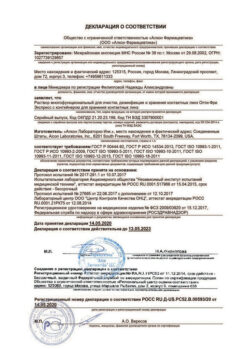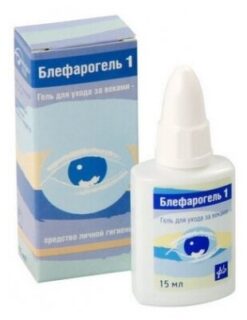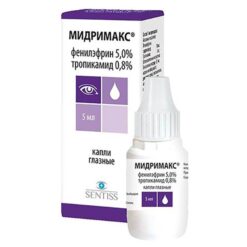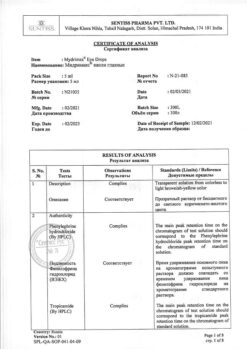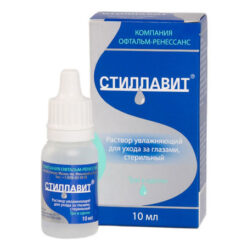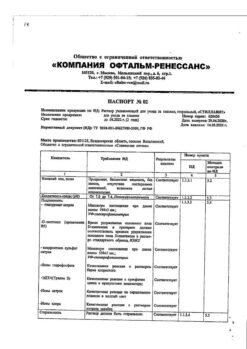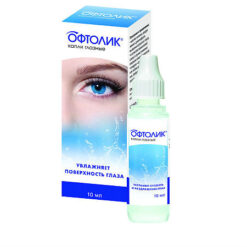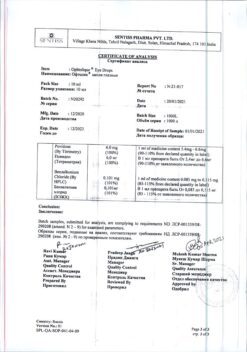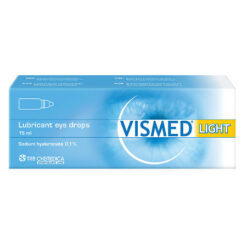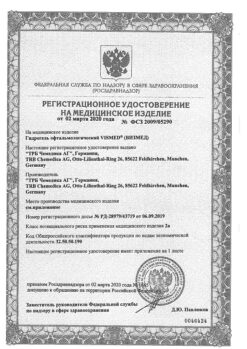No products in the cart.
Betaxolol-Optik, eye drops 0.5% 5 ml
€1.00
Out of stock
(E-mail when Stock is available)
Description Betaxolol is a selective β1-adrenoblocker without its own sympathomimetic activity. Application in the form of eye drops is accompanied by a decrease in intraocular pressure by reducing intraocular fluid production. The resorptive effect is expressed minimally. In addition, betaxolol improves ocular circulation (perfusion). It does not cause miosis, accommodation spasm due to reduction of aqueous humor production, hemeralopia.
Pharmacokinetics:
Betaxolol is highly lipophilic, resulting in rapid absorption by corneal epithelium and high concentration in intraocular fluid.
The time of onset of effect (decrease of intraocular pressure) is 30 minutes, the maximum effect – after 2 hours, the duration of action – 24 hours.
The half-life (T1/2) is 12-16 hours, plasma protein binding is 50%. It is eliminated mainly by the kidneys, to a small extent with the feces, as two carboxylic acids and unchanged (about 16% of the administered dose). Blood-brain barrier (BBB) and placental barrier permeability is low, secretion with breast milk is insignificant.
.
Indications
Indications
– Ocular hypertension;
Open angle glaucoma.
Active ingredient
Active ingredient
Composition
Composition
How to take, the dosage
How to take, the dosage
The drug is intended for local application only – in the conjunctival sac.
In adults (including elderly patients) into the conjunctival sac 1 drop 2 times a day.
When using the drug, avoid contact of the tip of the dropper dispenser with any surface to avoid microbial contamination.
Wash your hands thoroughly before dispensing the medication. Remove the cap and drip the medication into the conjunctival sac. If a drop does not enter the conjunctival sac, the next drop should be put in.
In order to minimize systemic absorption of the medication, it is advisable to squeeze the lacrimal ducts at the inner corner of the eye or close the eyelids for 2 minutes. This reduces the risk of systemic adverse reactions and increases local activity. Then wash hands to remove drug residue and close the bottle.
Interaction
Interaction
In patients receiving Betaxolol-Optic concomitantly receiving other oral β-adrenoblockers, the risk of adverse reactions (both systemic and local) may be higher due to possible additive effects. Such patients should be under close medical supervision.
β-adrenoblockers may worsen the effects of adrenaline used in anaphylactic reactions. The drug should be used with special caution in patients with a history of atopy or anaphylaxis.
When used concomitantly with sympathomimetics, increase their vasoconstrictor effect.
Cautious use of betaxololol and adrenergic psychotropic agents should be observed due to possible enhancement of their effects. If necessary, it may be used in combination with other topical ophthalmic drugs. In this case, the interval between their application should be at least 10 minutes.
Special Instructions
Special Instructions
If you have missed a dose of Betaxolol-Optic, take it as soon as possible. Do not take the missed dose if the next dose is approaching. The next dose should be taken at the proper time according to the treatment regimen. Do not double the dose.
Betaxolol does not affect pupil size, so in closed-angle glaucoma the drug should only be used in combination with myotics as a means of lowering intraocular pressure.
Diabetes
Patients with a history of spontaneous hypoglycemia and patients with labile diabetes should use β-adrenoblockers with caution because they may mask the signs and symptoms of acute hypoglycemia.
Thyrotoxicosis
The β-adrenoblockers may mask some symptoms of hyperthyroidism (e.g., tachycardia). In patients with suspected thyrotoxicosis, β-adrenoblockers should not be abruptly withdrawn, as this may cause worsening of symptoms.
Myasthenia gravis
The β-adrenoblockers may produce symptoms and signs similar to those of myasthenia gravis (e.g., diplopia, ptosis, and general weakness).
Surgery
Pulmonology
Caution should be exercised when prescribing β-adrenoblockers in patients with decreased respiratory function. Although clinical studies have shown no effect of betaxolol on respiratory function, the possibility of increased sensitivity to the drug should not be excluded.
The risk of anaphylactic reaction
Patients taking β-adrenoblockers may have a history of atopy or anaphylactic reactions. In case of recurrent reactions, these patients may not be sensitive to the usual doses of adrenaline necessary to stop anaphylaxis.
The drug should be used with caution in patients with severe peripheral circulatory disorders (i.e., Raynaud’s syndrome and pheochromocytoma).
When administered topically, β-adrenoblockers may enter the systemic bloodstream.
Thus, β-adrenoblockers may cause cardiovascular, pulmonary, and other adverse reactions, as with intravenous and parenteral administration. Serious respiratory and cardiovascular disorders have been described, including death from bronchospasm in patients with bronchial asthma and death from heart failure.
Cardiac disorders
In patients with cardiovascular disease (e.g., coronary heart disease, Prinzmetal angina, heart failure) and hypotension, therapy with β-adrenoblockers should be critically evaluated and treatment with other active agents should be considered. The appearance of signs of exacerbation and adverse reactions in patients with cardiovascular disease should be closely monitored.
Corneal diseases
The β-adrenoblockers may cause dry eye. The drug should be used with caution in patients with corneal diseases.
Vascular detachment
There have been cases of vascular detachment when using medications that prevent formation of intraocular fluid (e.g., timolol, acetazolamide) after filtration surgery.
We should be careful during treatment to drive vehicles and engage in other potentially dangerous activities that require high concentration and rapid psychomotor reactions.
Contraindications
Contraindications
– Hypersensitivity to betaxolol and other drug components;
– sinus bradycardia;
– sinus node weakness syndrome;
– sinoatrial block;
– Atrial-ventricular conduction block of degree II or III (AV blockade);
– cardiogenic shock;
– decompensated chronic heart failure;
– reactive respiratory disease, including bronchial asthma (including history
– severe chronic obstructive pulmonary disease;
– under 18 years of age.
While the overall effect of betaxolol (in the form of eye drops) on the body is mild, care should be taken when prescribing it to patients with thyrotoxicosis and diabetes mellitus (especially unstable) because the drug may mask the manifestations of hypoglycemia.
Before surgical intervention using general anesthesia the drug should be gradually discontinued, because the drug may change the patient’s reaction to the use of general anesthetics.
Betaxolol-Optic is a cardioselective drug that blocks pi-adrenergic receptors and has minimal effect on bronchial tone, but caution should be exercised when prescribing the drug in persons with upper airway obstructions.
Side effects
Side effects
The drug was generally well tolerated by patients.
The most common side effect was eye discomfort, which was reported in 12% of patients.
The following side effects are classified by frequency of occurrence according to the following gradation: Very common (≥10%); common (≥1%, <10%); infrequent (≥0.1%, <1%); rare (≥0.01%, <0.1%); very rare (<0.01%); frequency unknown (the incidence cannot be determined from available data).
Visual disorders:
Very common: transient eye discomfort;
Often: blurred vision, increased lacrimation;
Infrequent: pitting keratitis, keratitis, conjunctivitis, blepharitis, visual disturbances, photophobia, eye pain, dry eye syndrome, asthenopia, blepharospasm, itching in the eye, eye discharge, crust formation on the eyelid margins, inflammation, eye irritation, conjunctival disorders, conjunctival edema, eye hyperemia;
Rare: Cataract, decreased corneal sensitivity, eyelid redness; frequency unknown – detachment of ocular vasculature after filtration surgery, decreased corneal sensitivity, corneal erosion, ptosis, diplopia.
Nervous system disorders:
Often: headache;
Rarely: syncope;
Frequent unknown: dizziness, cerebrovascular disorders, cerebral ischemia, aggravation of the signs and symptoms of myasthenia gravis, paresthesia.
Mental disorders:
Rarely: anxiety;
Frequency unknown: insomnia, depression, nightmares, memory loss, hallucinations, psychosis, confusion.
Cardiac function disorders:
Infrequent: bradycardia, tachycardia;
Frequent unknown: arrhythmia, chest pain palpitations, edema, chronic heart failure, AV blockade, cardiac arrest, heart failure.
Vascular disorders:
Rarely: hypotension;
Prevalence unknown: Raynaud’s phenomenon, cold hands and feet, aggravation of intermittent claudication syndrome.
Disorders of the respiratory system, thorax and mediastinum:
Infrequent: bronchial asthma, dyspnea, rhinitis;
Rare: cough, rhinorrhea;
Frequent unknown: bronchospasm (mainly in patients with a history of bronchospastic disease).
Skin and subcutaneous tissue disorders:
Rarely: dermatitis, skin rash;
Frequent unknown: alopecia, psoriasiform rash or exacerbation of psoriasis.
Gastrointestinal disorders:
Infrequent: nausea;
Rare: dysgeusia; frequency unknown: dyspepsia, diarrhea, dry mouth, abdominal pain, vomiting.
Genital and breast disorders:
Rare: decreased libido;
Prevalence unknown: sexual disorders, impotence.
General disorders and disorders at the site of administration:
Prevalence unknown: asthenia, fatigue.
There have been other adverse reactions observed with topical administration of β-adrenoblockers that may develop with Betaxolol-Optic.
Disorders of the immune system:
Prevalence unknown: Systemic allergic reactions, including Quincke’s edema, urticaria, local and generalized rash, pruritus, and anaphylactic reactions.
Disorders of metabolism and nutrition:
Frequency unknown: hypoglycemia.
Musculoskeletal and connective tissue disorders:
Prevalence unknown: myalgia.
Overdose
Overdose
In case of ingestion of an excessive amount of the drug, the eyes should be flushed with warm water. In case of unintentional ingestion, symptoms of β1-adrenoblocker overdose may occur: bradycardia, arterial hypotension, acute heart failure and bronchospasm.
The treatment is symptomatic and supportive.
Similarities
Similarities
Additional information
| Shelf life | 2 years. Do not use after the expiration date printed on the package. The opened bottle can be used within 30 days. |
|---|---|
| Conditions of storage | In the original package, at a temperature not exceeding 25 ° C. Store out of the reach of children. |
| Manufacturer | Lekko ZAO, Russia |
| Medication form | eye drops |
| Brand | Lekko ZAO |
Other forms…
Related products
Buy Betaxolol-Optik, eye drops 0.5% 5 ml with delivery to USA, UK, Europe and over 120 other countries.


